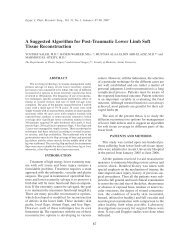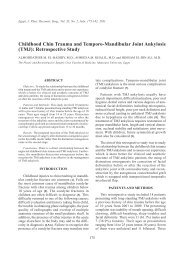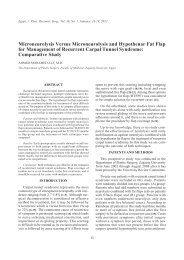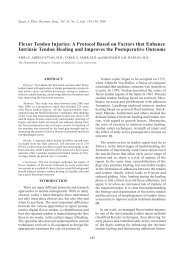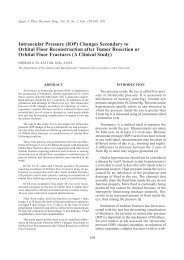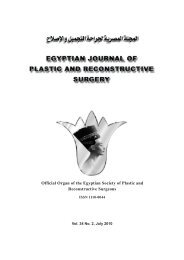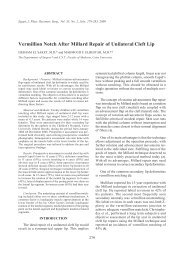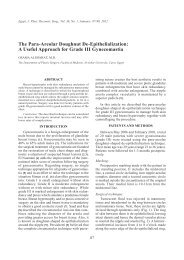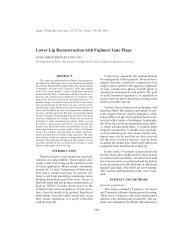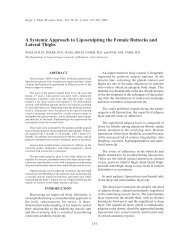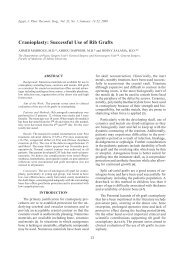Staged Division of Cross-Leg Flap to Enhance Flap ... - ESPRS
Staged Division of Cross-Leg Flap to Enhance Flap ... - ESPRS
Staged Division of Cross-Leg Flap to Enhance Flap ... - ESPRS
You also want an ePaper? Increase the reach of your titles
YUMPU automatically turns print PDFs into web optimized ePapers that Google loves.
Egypt, J. Plast. Reconstr. Surg., Vol. 34, No. 1, January: 49-54, 2010<br />
<strong>Staged</strong> <strong>Division</strong> <strong>of</strong> <strong>Cross</strong>-<strong>Leg</strong> <strong>Flap</strong> <strong>to</strong> <strong>Enhance</strong> <strong>Flap</strong> Viability by<br />
Increasing its Contact with the Reconstructed Bed<br />
KHALED S. ZAKARIA, M.D.; MOHAMMED FARAG, M.D.; AHMED ALI, M.D. and<br />
YEHYA M. ABDEL ROHMAN, M.D.<br />
The Department <strong>of</strong> Plastic Surgery, Faculty <strong>of</strong> Medicine, Ain Shams University, Cairo, Egypt.<br />
ABSTRACT<br />
The covering <strong>of</strong> s<strong>of</strong>t tissue defects <strong>of</strong> the lower leg and<br />
foot presents challenge for reconstructive surgeons, because<br />
<strong>of</strong> the paucity <strong>of</strong> local tissues especially in post-traumatic<br />
conditions. For this reason, several methods were used in<br />
reconstruction. In clinical practice, sometimes the surgeon<br />
becomes confronted with cases in which, the local ana<strong>to</strong>mical<br />
conditions, are difficult and the free flaps cannot be used due<br />
<strong>to</strong> technical or resource problems. In such cases, one <strong>of</strong> the<br />
best surgical alternatives remains the cross-leg flap procedure.<br />
Yet, sometimes a technical problem emerges if the contact<br />
surface area <strong>of</strong> the cross leg flap and the recipient bed is<br />
small. This may result in partial or <strong>to</strong>tal flap loss after flap<br />
division. To overcome this problem, a new modification is<br />
introduced <strong>to</strong> increase the contact surface area between the<br />
cross leg flap and its recipient bed by staged division <strong>of</strong> the<br />
cross-leg flap. This article will describe the use <strong>of</strong> this technique<br />
in coverage <strong>of</strong> difficult leg and foot defects in 16 patients.<br />
The article will also elaborate the versatility <strong>of</strong> the technique<br />
in reconstruction <strong>of</strong> below knee amputation stumps with<br />
satisfac<strong>to</strong>ry aesthetic and functional results. We consider that<br />
this technique <strong>of</strong>fers some advantages over the classical crossleg<br />
flap.<br />
INTRODUCTION<br />
S<strong>of</strong>t-tissue defects <strong>of</strong> the lower third <strong>of</strong> the leg<br />
and foot is a major reconstructive challenge because<br />
<strong>of</strong> a paucity <strong>of</strong> local tissues that could be reliably<br />
used [1,2]. Since the original description <strong>of</strong> the<br />
cross-leg flap by Hamil<strong>to</strong>n in 1854 [3] numerous<br />
refinements have been introduced <strong>to</strong> the technique<br />
[4,5]. It was considered for a long time <strong>to</strong> be the<br />
only option for covering defects <strong>of</strong> the distal third<br />
<strong>of</strong> the leg and foot [6]. With time, the cross-leg<br />
flap technique became a ''lost art''. It has been<br />
replaced by microsurgical composite-tissue transfer,<br />
which has evolved as the standard reconstructive<br />
procedure in such situations, with minimal morbidity<br />
and failure rates [7]. So the great enthusiasm<br />
generated microsurgical techniques made any talk<br />
about the cross-leg flap rather obsolete and did<br />
not allow the exploration <strong>of</strong> new concepts and<br />
applications. Free flaps, however, require special<br />
49<br />
skills and relatively expensive instrumentation not<br />
readily available in all reconstructive centres,<br />
particularly in under-privileged areas <strong>of</strong> the world.<br />
Moreover, in certain extreme conditions, freetissue<br />
transfer is highly risky or even impossible<br />
<strong>to</strong> perform. In such eventualities, the cross-leg flap<br />
re-emerges as a likely option for reconstruction<br />
[8]. Disadvantages <strong>of</strong> the classic cross-leg technique<br />
include an unreliable random blood supply,<br />
a short and thick pedicle that greatly limits the arc<br />
<strong>of</strong> rotation, and the need for uncomfortable pos<strong>to</strong>perative<br />
immobilization in an awkward posture<br />
[4,9]. Complications and failure <strong>to</strong> cover the wound<br />
are frequent [9,10].<br />
The cross leg flap is safe and reliable in resurfacing<br />
<strong>of</strong> large defects <strong>of</strong> the lower limb and foot.<br />
[6]. Several modifications were introduced published<br />
<strong>to</strong> enhance vascularity and the versatility<br />
<strong>of</strong> cross leg flap as incorporating fascial extension<br />
in the flap [11] or muscle [12]. Other modifications<br />
included adapting the distally based sural fasciocutaneous<br />
flap as a cross-leg flap having the advantage<br />
<strong>of</strong> the comfortable leg positioning and the<br />
simplicity over the standard cross-leg flap [8].<br />
<strong>Cross</strong> leg flaps based on the perfora<strong>to</strong>rs <strong>of</strong> the<br />
posterior tibial artery were other recent modifications<br />
for the cross leg flaps [13].<br />
Despite <strong>of</strong> all these options and modifications,<br />
the cross leg flap whether conventional or modified<br />
still faces some problems in practical application,<br />
especially if there is a small contact surface area<br />
between the flap and its underlying bed. The aim<br />
<strong>of</strong> this article is <strong>to</strong> introduce a modification in the<br />
use <strong>of</strong> the conventional cross leg flap by staged<br />
division <strong>of</strong> the flap after one week <strong>to</strong> enhance flap<br />
viability by increasing contact between the flap<br />
and the underlying reconstructed bed. The article<br />
will demonstrate the different applications <strong>of</strong> the
50 Vol. 34, No. 1 / <strong>Staged</strong> <strong>Division</strong> <strong>of</strong> <strong>Cross</strong>-<strong>Leg</strong> <strong>Flap</strong> <strong>to</strong> <strong>Enhance</strong> <strong>Flap</strong> Viability<br />
technique including its use in reconstruction <strong>of</strong><br />
below knee amputation stumps.<br />
PATIENTS AND METHODS<br />
The study was conducted in the Department <strong>of</strong><br />
Plastic Surgery <strong>of</strong> Ain Shams University Hospitals<br />
from January 2003 <strong>to</strong> December 2005 with followup<br />
<strong>of</strong> an average 9 months. It was carried on 16<br />
patients with different skin defects along the leg<br />
and foot. Of these 16 patients there were 12 males<br />
and 4 females. The age ranged from 6 <strong>to</strong> 31 years.<br />
The causes <strong>of</strong> these defects were recent trauma<br />
except for one case the defect was unstable scar<br />
due <strong>to</strong> old trauma. The sites <strong>of</strong> these defects were<br />
in the lower third <strong>of</strong> leg (3 cases), lower 1/3 <strong>of</strong> the<br />
leg and ankle region (4 cases) combined middle<br />
and lower thirds (5 cases) below knee amputation<br />
stump (3 cases) and the heal area (one case) (Table<br />
1).<br />
Operative technique:<br />
All cases were operated upon under general<br />
anesthesia at variable intervals according <strong>to</strong> the<br />
time <strong>of</strong> their presentation which ranged from few<br />
days up <strong>to</strong> three months. In cases presented with<br />
compound fractures, aggressive debridement <strong>of</strong><br />
the wound was done with simultaneous removal<br />
<strong>of</strong> all non viable bones. External fixation was done<br />
and medial external fixation was replaced by lateral<br />
one by the aid <strong>of</strong> orthopedic surgeons. In one case<br />
presented with unstable scar, preoperative excision<br />
biopsy and his<strong>to</strong>pathological examination was done<br />
<strong>to</strong> exclude any malignant change.<br />
Operative technique:<br />
Preoperative assessment <strong>of</strong> the patient was<br />
done. The expected defect site and size were determined<br />
and accurate design <strong>of</strong> the cross leg flap<br />
location and size was done, after putting the patient’s<br />
legs in the optimum position for the flap <strong>to</strong><br />
reach its future bed. Through a lateral approach<br />
and under pneumatic <strong>to</strong>urniquet using loupe magnification,<br />
the distal end <strong>of</strong> the flap is raised including<br />
about 1-2cm fascial extension. This extension<br />
was only included in the part <strong>of</strong> the flap that<br />
will have primary good contact with the reconstructed<br />
bed aiming <strong>to</strong> enhance flap neovascularisation<br />
(Fig. 1-A). Dissection then continues medially.<br />
The skin segment needed is divided proximally<br />
and distally and the short saphenous vein and the<br />
sural nerve are exposed and identified and then<br />
divided burying their cut ends under the proximal<br />
and distal leg skin. Careful haemostasis is done.<br />
Skin graft is applied <strong>to</strong> the cross leg flap donor<br />
with tie over.<br />
The flap is then inset keeping the maximum<br />
contact between the flap and its bed. The fascial<br />
extension is tucked under the edge <strong>of</strong> the defect<br />
by transfixation sutures. The part <strong>of</strong> the flap that<br />
was not in contact with the defect is just left hanging<br />
or attached by loose stitches <strong>to</strong> the future bed <strong>to</strong><br />
prevent it from being retracted or tubed upon itself<br />
(Fig. 1-B).<br />
The first pos<strong>to</strong>perative dressing is done after<br />
seven days under general anaesthesia. Curettage<br />
<strong>of</strong> the under surface <strong>of</strong> the hanging part <strong>of</strong> the<br />
cross leg flap is done. Then this portion is divided<br />
converting it <strong>to</strong> a random pattern flap with length<br />
<strong>to</strong> width ratio 1:1 (Fig. 1-C). The newly formed<br />
flap is then allowed <strong>to</strong> lie comfortably on the<br />
desired bed. In cases with below knee amputation<br />
the whole flap is turned up <strong>to</strong> cover the tip and the<br />
posterior surface <strong>of</strong> the stump (Fig. 1-D). The flap<br />
is then left for another two weeks then division <strong>of</strong><br />
the remaining part <strong>of</strong> the flap is done.<br />
RESULTS<br />
The whole sixteen flaps survived completely<br />
without single flap loss (Figs. 2-3). In one patient<br />
persistent discharge occurred from underlying bone<br />
infection and partial disruption occurred. This was<br />
managed by flap elevation, further debridement <strong>of</strong><br />
necrotic bone leaving bone defect about 5cm with<br />
application <strong>of</strong> illizarov fixa<strong>to</strong>r where segment<br />
transfer was done later.<br />
Complete take <strong>of</strong> the skin grafts occurred in<br />
fifteen patients with complete healing <strong>of</strong> graft<br />
donors, except one patient had partial graft loss <strong>of</strong><br />
the donor flap and needed another skin grafting<br />
session. All patients had stable wound coverage<br />
during the follow-up period without the need <strong>of</strong><br />
secondary procedures, during the same follow-up<br />
period. No functional deficits were encountered<br />
and flap donor sites were aesthetically accepted.<br />
Table (1): Location, etiology and number <strong>of</strong> defects.<br />
Site <strong>of</strong> the defect<br />
Lower 1/3 <strong>of</strong> the leg<br />
Lower 1/3 <strong>of</strong> the leg and ankle region<br />
Combined middle & lower 1/3 <strong>of</strong> the leg<br />
Below knee amputation stump<br />
Heel<br />
Total<br />
Etiology<br />
Trauma<br />
Trauma<br />
Trauma<br />
Trauma<br />
Unstable<br />
scar<br />
No. <strong>of</strong><br />
defects<br />
3<br />
4<br />
5<br />
3<br />
1<br />
16
Egypt, J. Plast. Reconstr. Surg., January 2010 51<br />
Fig. (1-A): Raised<br />
flap including [1cm] <strong>of</strong><br />
the leg fascia in the part<br />
planned <strong>to</strong> have primary<br />
good contact with<br />
the reconstructed bed.<br />
Fig. (1-C): <strong>Staged</strong> division <strong>of</strong> flap after 1 week, creating a<br />
random pattern flaps (width <strong>to</strong> length ratio 1:1).<br />
Fig. (2-A): Post traumatic exposed lower<br />
1/3 leg, ankle and tarsal bones, notice an eaten<br />
part <strong>of</strong> the articular cartilage <strong>of</strong> ankle joint<br />
with tip <strong>of</strong> K-wire fixation.<br />
Fig. (1-B): In first<br />
stage distal part <strong>of</strong> the<br />
flap is spread and left<br />
attached distally <strong>to</strong> prevent<br />
flap retraction.<br />
Fig. (1-D): <strong>Flap</strong> covering anterior, posterior surface and the<br />
tip <strong>of</strong> below knee amputation stump.<br />
Fig. (2-B): Lower half <strong>of</strong> the<br />
flap attached <strong>to</strong> the distal point <strong>of</strong><br />
the defect <strong>to</strong> prevent its retraction,<br />
the medial part <strong>of</strong> the distal half<br />
<strong>of</strong> the flap is left hanging with no<br />
contact.<br />
Fig. (2-C): <strong>Cross</strong> leg flap<br />
with staged division after 1<br />
week. The hanging part <strong>of</strong> the<br />
flap is now in good contact with<br />
its bed.
52 Vol. 34, No. 1 / <strong>Staged</strong> <strong>Division</strong> <strong>of</strong> <strong>Cross</strong>-<strong>Leg</strong> <strong>Flap</strong> <strong>to</strong> <strong>Enhance</strong> <strong>Flap</strong> Viability<br />
Fig. (2-D): Late pos<strong>to</strong>perative with good cover <strong>of</strong><br />
the lower third leg and ankle joint (lateral view).<br />
Fig. (3-B): Below knee<br />
amputation stump after reconstruction<br />
by staged division<br />
<strong>of</strong> cross leg flap.<br />
Fig. (2-E): Pos<strong>to</strong>perative with<br />
good cover <strong>of</strong> the lower third leg<br />
and ankle joint (P-A view).<br />
Fig. (3-D,E): Pos<strong>to</strong>perative good cover <strong>of</strong> the amputation stump.<br />
Fig. (3-A): Exposed below<br />
knee amputation stump <strong>of</strong> right leg.<br />
Fig. (3-C): Preoperative lateral view <strong>of</strong> the amputation stump.
Egypt, J. Plast. Reconstr. Surg., January 2010 53<br />
DISCUSSION<br />
For a long period <strong>of</strong> time cross-leg flaps were<br />
the only reconstructive option for the difficult areas<br />
<strong>of</strong> the distal leg and foot, with high success rates<br />
and minimal morbidity in expert hands [6]. <strong>Cross</strong><br />
leg flaps, however, are highly technique dependent,<br />
which explains the variable success rates described<br />
in the literature. These flaps were described as<br />
being handicapped by the inherent problems <strong>of</strong><br />
positioning and immobilization [14], because <strong>of</strong><br />
their short, thick and inextensible pedicles, awkward<br />
postures and bulky external fixation devices<br />
are invariably needed [15,16].<br />
In comparison <strong>to</strong> one-stage reconstruction using<br />
free flaps [7,9,17,18] cross-leg flaps require at least<br />
two surgical stages. Moreover, they do not augment<br />
the blood supply <strong>of</strong> the recipient defect. Despite<br />
all the technical improvements and the experience<br />
gained in clinical practice over the last three decades,<br />
micro-anas<strong>to</strong>motic thrombosis with incidence<br />
<strong>of</strong> flap failure remains a source <strong>of</strong> frustration<br />
<strong>to</strong> most microsurgeons [16]. Some conditions carry<br />
higher risks for failure, such as traumatic defects<br />
in the sub-acute phase, lack <strong>of</strong> direct pulsatile<br />
inflow and lack <strong>of</strong> suitable vessels in the recipient<br />
bed, necessitating the use <strong>of</strong> inter-positional vein<br />
grafts [9,17,18,20]. To minimize free-flap failure,<br />
several guidelines, techniques and modifications<br />
have been proposed [9,17,18].<br />
Despite the widespread use <strong>of</strong> microsurgery in<br />
management <strong>of</strong> lower leg injuries, still the cross<br />
leg flaps have their role. However they have the<br />
disadvantage <strong>of</strong> prolonged immobilization and<br />
incidence <strong>of</strong> partial or <strong>to</strong>tal flap loss. Several<br />
modifications were published <strong>to</strong> overcome this<br />
incidence <strong>of</strong> failure by delaying the division <strong>of</strong> the<br />
flap or incorporating fascial extension in the flap.<br />
In this paper we described a new modification<br />
<strong>to</strong> enhance the vascularity <strong>of</strong> the flap and <strong>to</strong> minimize<br />
the incidence <strong>of</strong> partial or <strong>to</strong>tal flap loss.<br />
<strong>Staged</strong> division <strong>of</strong> the flap was done <strong>to</strong> enhance<br />
its contact with the receiving bed. This allowed us<br />
<strong>to</strong> have good success <strong>of</strong> all the flaps. This modification<br />
is especially indicated in large leg defects,<br />
particularly if they are including the distal third<br />
<strong>of</strong> the leg and foot in which the full contact between<br />
the flap and the bed is difficult <strong>to</strong> be achieved.<br />
This is also applicable in cases <strong>of</strong> amputation<br />
stumps where the geometry <strong>of</strong> the defect does not<br />
also allow complete contact <strong>of</strong> the flap with its<br />
bed.<br />
It is safe and reliable procedure <strong>to</strong> cover large<br />
defects in the lower limb. At the same time this<br />
technique avoided exposing the patients <strong>to</strong> a lengthy<br />
microsurgical procedure with all the hazards <strong>of</strong><br />
this operation. Dividing the flap after one week<br />
did not have any drastic effect on the viability <strong>of</strong><br />
the divided part <strong>of</strong> the flap because it was designed<br />
<strong>to</strong> respect all the rules <strong>of</strong> the random pattern flap<br />
with width <strong>to</strong> length ratio not exceeding 1:1.<br />
Conclusion:<br />
The cross-leg flap may prove <strong>to</strong> be a highly<br />
valuable reconstructive option in situations in<br />
which microsurgical free-tissue transfer is not<br />
possible. This may be due <strong>to</strong> problems related <strong>to</strong><br />
the patient general conditions or lack <strong>of</strong> microsurgical<br />
facilities. The staged division <strong>of</strong> cross leg<br />
flap allows safe reconstruction <strong>of</strong> difficult defects<br />
that were partially not amenable <strong>to</strong> reconstruction<br />
by the conventional cross leg flap. It is also beneficial<br />
in cases <strong>of</strong> exposed below knee amputation<br />
stumps. The only disadvantage <strong>of</strong> the technique is<br />
adding another stage <strong>to</strong> the procedure <strong>of</strong> conventional<br />
cross leg flap.<br />
REFERENCES<br />
1- Musharafieh R., Atiyeh B., Macari G. and Haidar R.:<br />
Radial forearm fasciocutaneous free-tissue transferin<br />
ankle and foot reconstruction: Review <strong>of</strong> 17 cases. J.<br />
Reconstr. Microsurg., 17: 147, 2001.<br />
2- Fraccalvieri M., Verna G., Dolcet M., et al.: The distally<br />
based superficial sural flap: Our experience in reconstructing<br />
the lower leg and foot. Ann. Plast. Surg., 45: 132,<br />
2000.<br />
3- Long C.D., Granick M.S. and Solomon M.P.: The crossleg<br />
flap revisited. Ann. Plast. Surg., 30: 560, 1993.<br />
4- Stark R.B.: The cross-leg flap procedure. Plast. Reconstr.<br />
Surg., 9: 173, 1952.<br />
5- Pollock W.J. and Parkes J.C., II.: Technical details in the<br />
management <strong>of</strong> cross-leg flaps. J. Trauma, 10: 663, 1970.<br />
6- Morris A.M. and Buchan A.C.: The place <strong>of</strong> the cross leg<br />
flap in reconstructive surgery <strong>of</strong> the lower leg and foot:<br />
A review <strong>of</strong> 165 cases. Br. J. Plast. Surg., 31: 138, 1978.<br />
7- Atiyeh B.S.: Microsurgical composite tissue transfer: An<br />
expanding horizon in reconstructive surgery. J. Med.<br />
Liban., 42: 112, 1994.<br />
8- Atiyeh B.S., Al-Amm C. A., El-Musa K.A., Sawwaf A.W.<br />
and Musharafieh R.S.: Distally Based Sural Fasciocutaneous<br />
<strong>Cross</strong>-<strong>Leg</strong> <strong>Flap</strong>: A New Application <strong>of</strong> an Old<br />
Procedure. Plast. Reconstr. Surg., 113 (2): 1470-4, 2004.<br />
9- Atiyeh B.S., Khalil I.M., Hussein M.K., et al.: Temporary<br />
arterio-venous fistula and microsurgical free tissue transfer<br />
for reconstruction <strong>of</strong> complex defects. Plast. Reconstr.<br />
Surg., 108: 485, 2001.<br />
10- Cannon B., Constable J.D., Furlow L.T., et al.: Reconstructive<br />
surgery <strong>of</strong> the lower extremity. In J.M. Converse<br />
(Ed.), Reconstructive Plastic Surgery. Philadelphia: Saunders,<br />
1977.
54 Vol. 34, No. 1 / <strong>Staged</strong> <strong>Division</strong> <strong>of</strong> <strong>Cross</strong>-<strong>Leg</strong> <strong>Flap</strong> <strong>to</strong> <strong>Enhance</strong> <strong>Flap</strong> Viability<br />
11- Barclay T.L., Sharpe D.T. and Chisholm E.M.: <strong>Cross</strong> leg<br />
fasciocutaneous flaps. Plast. Reconstr. Surg., 72: 843,<br />
1983.<br />
12- Orticochia M.: Immediate (undelayed) musculocutaneous<br />
island cross leg flaps. Br. J. Plast. Surg., 31: 205, 1978.<br />
13- Georgescu A.V., Irina C. and Ileana M.: <strong>Cross</strong>-leg tibial<br />
posterior perfora<strong>to</strong>r flap. Microsurgery, 27 (5): 380-383,<br />
2007.<br />
14- Dawson R.L.: Complications <strong>of</strong> the cross-leg flap operation.<br />
Proc. R. Soc. Med., 65: 626, 1972.<br />
15- Arnander C., Eriksson G., Korl<strong>of</strong> B. and Nylen B.: Transfixation<br />
in cross-leg procedures using H<strong>of</strong>fman’s instruments:<br />
Report <strong>of</strong> forty-two cases. Scand. J. Plast. Reconstr.<br />
Surg., 9: 68, 1975.<br />
16- Constant E. and Grabb W.: Steinmann pin fixation <strong>of</strong> tibia<br />
for cross-leg flap. Plast. Reconstr. Surg., 41: 179, 1968.<br />
17- Atiyeh B.S., Sfeir R.E., Hussein M.M. and Hussami T.:<br />
Preliminary arterio-venous fistula for free-flap reconstruction<br />
in the diabetic foot. Plast. Reconstr. Surg., 95: 1062,<br />
1995.<br />
18- Atiyeh B.S. and Musharafieh R.S.: <strong>Staged</strong> arteriovenous<br />
fistula and free flap transfer (Letter). Ann. Plast. Surg.<br />
38: 193, 1997.<br />
19- Scotland M.A. and Kerrigan C.L.: The role <strong>of</strong> platelet<br />
activating fac<strong>to</strong>r in musculocutaneous flap perfusion<br />
injury. Plast. Reconstr. Surg., 99: 1989, 1997.<br />
20- Godina M.: Early microsurgical reconstruction <strong>of</strong> complex<br />
trauma <strong>of</strong> the extremities. Plast. Reconstr. Surg., 78: 285,<br />
1986.




